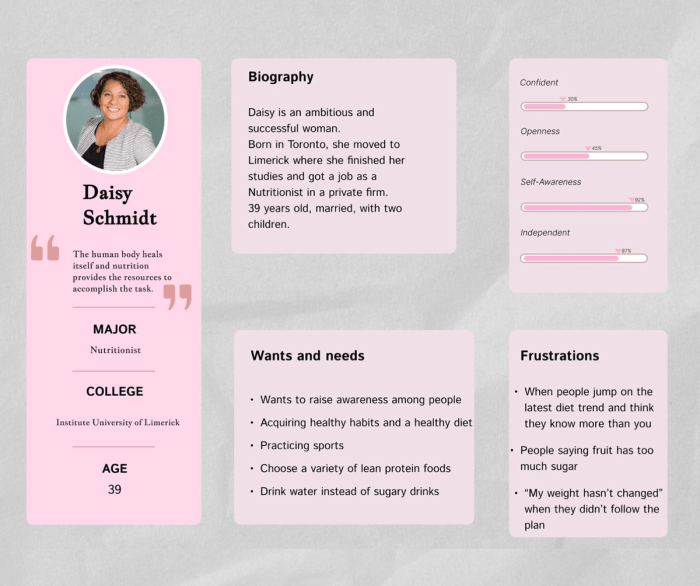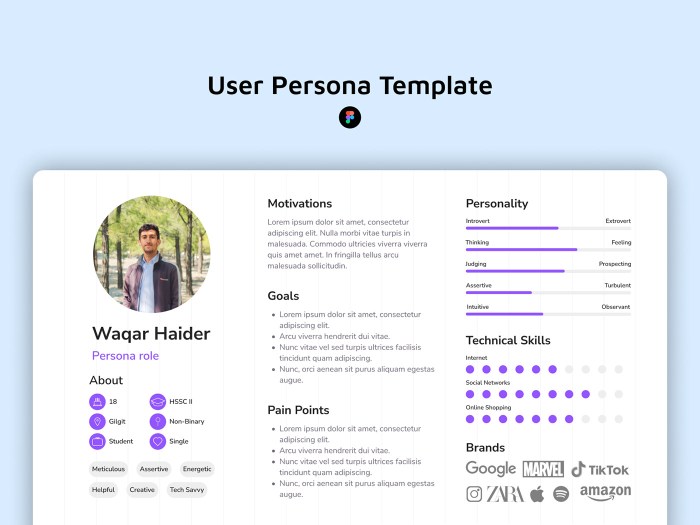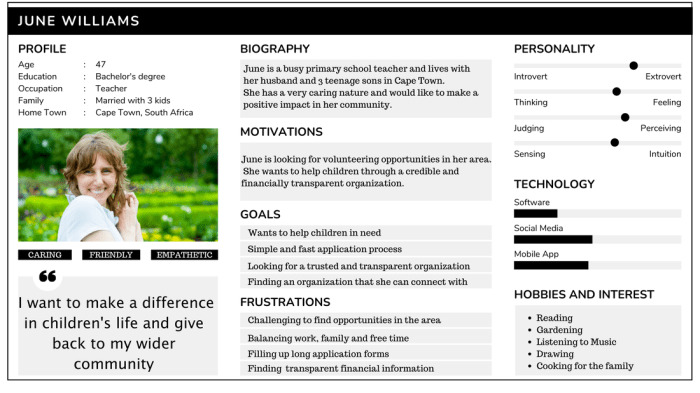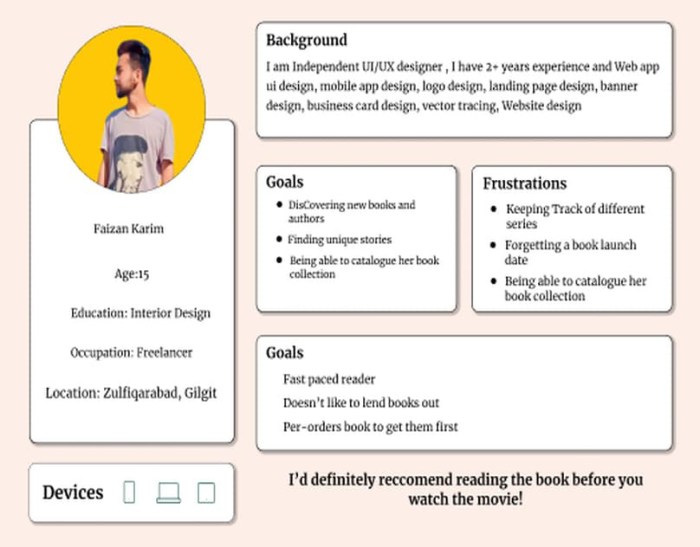Crafting effective user personas is crucial for successful product design. Understanding your target audience goes beyond demographics; it delves into their motivations, frustrations, and daily lives. By meticulously defining user personas, designers can create products and services that resonate deeply with their intended users, leading to increased engagement and satisfaction.
This process involves a structured approach, moving from initial audience research to the visual representation of a typical user. Each step builds upon the previous one, culminating in a comprehensive understanding that informs every design decision, from navigation menus to app features. This guide Artikels a six-step process to help you create compelling and insightful user personas.
Understanding Your Target Audience

Creating accurate and representative user personas is crucial for effective design. By deeply understanding your target audience, you can tailor your product or service to meet their specific needs and preferences, ultimately leading to increased user satisfaction and adoption. This involves more than just demographics; it requires understanding their motivations, frustrations, and daily lives.
Let’s delve into practical examples to illustrate this process.
A Young Professional’s Persona: Sustainable Living
Consider a user persona representing a young professional, aged 25-35, deeply interested in sustainable living. We’ll call her Anya. Anya works as a marketing manager in a large city, juggling a demanding career with a commitment to environmentally conscious choices. Her daily routine involves cycling to work, preparing her own lunches using locally sourced ingredients, and participating in community gardening initiatives. Her motivation stems from a genuine concern for the environment and a desire to live a more ethical and meaningful life. However, she faces frustrations like the high cost of sustainable products, the lack of convenient options for eco-friendly choices, and the time commitment required to make sustainable choices in a fast-paced urban environment. Anya values convenience and efficiency but is willing to invest time and money if the environmental benefits are clear and tangible.
Comparison of User Personas Across Different Demographics
The following table illustrates how user needs and experiences can differ significantly across demographics, even when using the same application. Understanding these differences is key to creating a truly inclusive and user-friendly design.
| Persona | Tech Proficiency | Daily Use Case | Frustrations |
|---|---|---|---|
| Tech-Savvy Teenager (15 years old) | High; comfortable with various platforms and apps | Uses the app for social media integration, quick access to information, and gaming features | Slow loading times, lack of intuitive navigation, limited customization options, and intrusive ads. |
| Senior Citizen (70 years old) | Low; prefers simple interfaces and large font sizes | Uses the app for communication with family, accessing news, and managing appointments. | Complex menus, small text sizes, lack of clear instructions, and difficulty navigating features. |
The Importance of Empathy in Persona Development
Empathy plays a vital role in crafting accurate and useful user personas. It’s not enough to simply gather demographic data; you need to understand the emotional landscape of your users. For example, understanding Anya’s frustration with the high cost of sustainable products allows designers to explore cost-effective solutions or highlight the long-term cost savings associated with sustainable choices. Similarly, recognizing a senior citizen’s potential difficulties with complex interfaces can lead to the development of simpler, more intuitive designs with larger fonts and clear visual cues. By understanding user emotions – their anxieties, hopes, and frustrations – designers can make informed choices that improve the overall user experience and foster a stronger connection between users and the product.
Defining Persona Attributes

Developing robust user personas is crucial for effective product design and marketing. A well-defined persona allows designers and developers to empathize with their target audience, making informed decisions about features, functionality, and overall user experience. This section will delve into the process of defining the attributes of a user persona, using the example of a busy parent utilizing meal delivery services.
Meal Delivery Persona Scenarios
Let’s consider Sarah, a busy parent, as our example. Understanding her needs and pain points during the meal delivery ordering process is key to creating a user-friendly service. Here are three distinct scenarios illustrating her experience:
- Scenario 1: The Quick Lunch Rush: Sarah needs a quick and easy lunch solution for herself and her kids. She’s short on time and needs a healthy, kid-friendly option delivered within an hour. Her pain point is finding options that cater to both her and her children’s dietary needs without extensive browsing.
- Scenario 2: The Weeknight Dinner Dilemma: Sarah is exhausted after a long day at work and needs a convenient dinner solution for her family. She needs a service with a wide selection of family-sized meals, clear nutritional information, and easy-to-use filtering options. Her pain point is navigating a complex menu with too many choices, and difficulty finding meals that fit her family’s dietary restrictions.
- Scenario 3: The Unexpected Guest: Sarah has unexpected guests arriving and needs a last-minute meal solution. She needs a service with fast delivery times, a wide variety of options, and clear pricing. Her pain point is finding a service with sufficient availability on short notice and dealing with unexpected delivery fees or delays.
Key Attributes for a User Persona
To create a comprehensive user persona, several key attributes should be included. These attributes provide a holistic understanding of the user and their relationship with your product or service.
- Demographics: This includes age, gender, location, income level, family status, and education. For Sarah, this might include: 35 years old, female, suburban location, middle-income, married with two children, college-educated.
- Goals: What are the user’s objectives when interacting with the product or service? For Sarah, her goals might include saving time, providing healthy meals for her family, reducing cooking stress, and enjoying convenient dining options.
- Frustrations: What challenges or pain points does the user experience when using the product or service? As highlighted in the scenarios above, Sarah’s frustrations might include complex menus, limited healthy options, long delivery times, and unclear pricing.
- Technology Proficiency: Understanding the user’s comfort level with technology is crucial. Sarah might be proficient in using smartphones and apps, but may prefer a simple, intuitive interface.
- Psychographics: This includes the user’s values, lifestyle, interests, and attitudes. Sarah might value convenience, health, family time, and budget-consciousness.
Visual Representation of Sarah
Sarah’s persona visual would feature a headshot of a smiling, relatable woman in her mid-thirties, possibly with a child peeking in the background. The photo would have a slightly soft, warm filter to create a friendly and approachable image. The color palette would use soft, muted tones like light blues, greens, and creams, conveying a sense of calm and approachability. A brief summary could read: “Sarah is a busy working mom who values convenience and healthy eating but struggles to find the time to plan and prepare meals for her family. She relies on meal delivery services to simplify her life and reduce stress.”
Applying Personas to Design Decisions

User personas are not merely theoretical constructs; they are powerful tools that directly impact design choices across various platforms. By understanding the specific needs, motivations, and frustrations of your target users, you can create more intuitive, efficient, and ultimately, successful designs. This section will explore how personas guide decision-making in website navigation, mobile app development, and new software feature design.
Website Navigation Menu Design Guided by Personas
A well-designed website navigation menu is crucial for user experience. A persona can significantly influence its structure and content. Consider a website selling handcrafted jewelry. If our primary persona is “Sarah,” a busy professional aged 35-45, interested in high-quality, minimalist pieces, the navigation would likely prioritize clear categories like “Necklaces,” “Earrings,” “Bracelets,” with potentially subcategories based on material (e.g., “Silver,” “Gold”). A search bar would also be prominent, allowing Sarah to quickly find specific items. In contrast, if our persona were “Mia,” a younger, trend-conscious individual, the menu might incorporate visually appealing imagery and emphasize trending styles and collections. The use of s like “Boho,” “Edgy,” or “Vintage” would be prominent, alongside visually driven navigation.
Mobile App Design for Distinct User Personas
The design of a mobile game app would vary drastically depending on the target user. Let’s compare a casual gamer persona (“Casual Carl”) with a hardcore gamer persona (“Hardcore Hannah”).
- Casual Carl: The app would feature simple, intuitive controls, short game sessions, and easily understandable progression systems. In-app purchases would be optional and clearly presented, focusing on cosmetic items rather than pay-to-win mechanics. The UI would be clean and uncluttered, prioritizing ease of access and immediate gameplay.
- Hardcore Hannah: The app would prioritize depth and complexity, offering challenging gameplay, customizable controls, and extensive progression systems. In-app purchases might be more integrated into gameplay, potentially offering advantages, but always transparently. The UI would be more detailed, allowing for extensive customization and access to detailed stats and information.
Flowchart: User Persona Guiding New Feature Design
The following flowchart illustrates how a user persona guides the design process for a new feature in a project management software application.
Step 1: Define Persona: Identify the primary user persona (e.g., “Project Manager, David”). This step involves defining David’s goals, tasks, frustrations, and technical proficiency.
Step 2: Identify Need: Based on David’s persona, identify a specific need or pain point that a new feature could address (e.g., difficulty tracking team member progress).
Step 3: Feature Concept: Brainstorm potential features to address the identified need (e.g., a real-time progress tracking dashboard).
Step 4: Prototype & Test: Create a prototype of the proposed feature and test it with David (or users mirroring his persona).
Step 5: Iterate Based on Feedback: Refine the feature design based on user testing feedback, ensuring it aligns with David’s needs and expectations.
Step 6: Launch & Monitor: Launch the feature and monitor its usage and effectiveness. Gather data to inform future iterations.
Closing Notes

Successfully designing user personas requires a blend of research, empathy, and creative visualization. By following these six steps, you can move beyond superficial understanding to create truly representative profiles that drive informed design choices. Remember, the goal is not just to create a profile, but to empathize with your users and build products that genuinely meet their needs and expectations. The investment in thorough persona development will ultimately yield a more user-friendly and successful product.